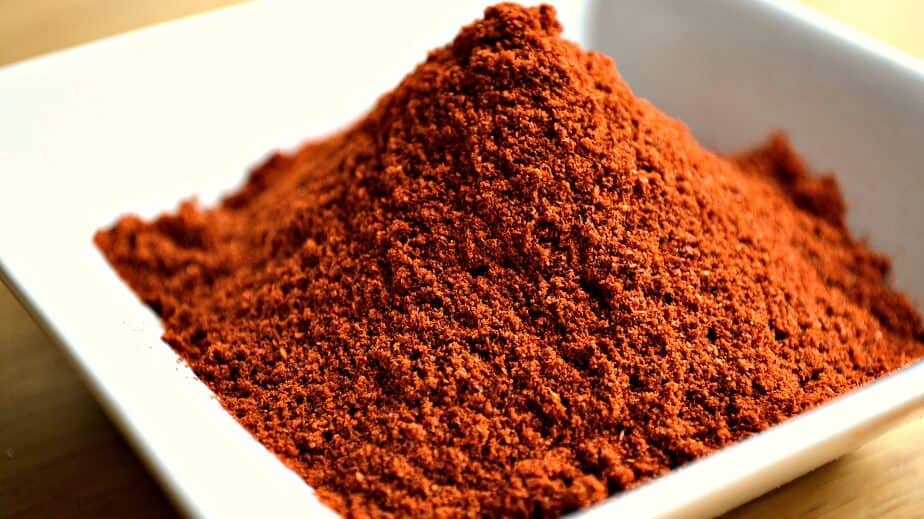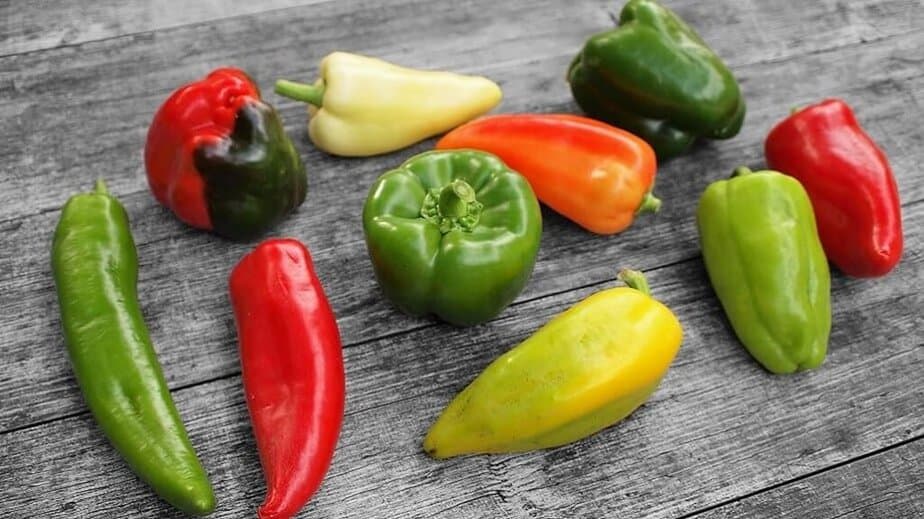What Is Paprika?
Paprika is a ground spice made from a blend of dried and ground ripened fruits of moderately hot peppers in the Capsicum annuum species. It’s made of peppers like cayenne peppers, chili peppers, Aleppo peppers, poblano pepper, and others.
This ground pepper mixture is mildly flavored and prized for its brilliant red color. It’s closely related to red pepper (cayenne), the most popular pepper of the Capsicum annuum species.
By the way, paprika is different from chili powder. It’s made only of chilies and has a sweetness to it. Chili powder, on the other hand, is a seasoning spice made with a mixture of different types of chili peppers as a base with garlic powder and cumin. Favor-wise, chili powder is usually spicier than paprika.
What Does Paprika Taste Like?
The flavor of paprika differs according to the type of peppers and their origin. Most varieties of paprika are moderately spicy but a few of them are made with fiery hot peppers. Others are sweet with no heat.
The spiciness of paprika depends on the flavorful carotenoids present in the fresh peppers that go into the making of the powder.
What Is Paprika Used for?
Paprika is a ubiquitous item invariably found in every kitchen across the world. Its common uses in cooking include:
- season dishes
- garnish foods
- add a hot or sweet flavor to dishes
- add color to recipes.
It goes well with a wide variety of savory dishes such as meat, eggs, poultry, fish, stew, soup, creamy sauces, steamed vegetables, rice, and more.
Preferably, paprika is added towards the end of the cooking process as overheating can diminish both the flavor and color.
Types of Paprika
There are 3 different types of paprika and all the verities have significant differences in flavor and color. Very often when a recipe calls for hot or smoked paprika, most home chefs end up sprinkling in the regular stuff instead.
Sweet paprika: Also labeled as Hungarian paprika, is the most commonly used paprika; made from bright, sweet red peppers that don’t have much heat and spiciness.
Hot paprika: Made with extra-spicy red peppers, hot paprika is, of course, very hot and spicy; cayenne or other ground chilies go into its making.
Smoked paprika: Red peppers are dried and smoked over an oak fire to make smoked paprika. It’s a Spanish version of paprika that can be made from both sweet and hot pepper varieties.
Q&A Facts on Paprika
Here are a few common Q&A facts about paprika:
Where does paprika come from?
The peppers used in paprika production originated from North America, where they grow in the wild in Central Mexico and have for centuries been cultivated for centuries. In fact, Capsicum Annuum species of peppers belonging to the nightshade, Solanaceae family are native to tropical areas of the Western Hemisphere, including Mexico, the West Indies, and South America.
Is smoked paprika spicy?
Smoked paprika, also called pimenton or smoked Spanish paprika, is made of peppers that are smoked and dried over oak fires. This smoked variety of pepper has a smoky flavor and heat varies according to the type of peppers included. You can find 3 versions of smoked paprika which are mild, medium-hot, and hot.
What are the differences between paprika and smoked paprika?
Regular paprika is made of dried crushed chili peppers, whereas, smoked paprika contains smoke-dried ground chili peppers. Usually, regular paprika is sundried chili peppers but smoked paprika is dried over an oak fire.
What is Spanish paprika?
Smoked paprika is also known as Spanish paprika. They are made from peppers that are smoked, dried, and then ground in powder. This ground pepper has an earthy complex flavor with distinctive notes of smokiness.
What is Hungarian paprika?
In the Hungarian language, the word paprika refers to pepper. Hungarian-style paprika is hot and sweet and is generally accepted as superior to all other varieties. It’s made from peppers that are specially sorted, toasted, and blended to create different varieties.
What Is Paprika Good for?
The capsaicin compound in paprika has been proven to have a wide range of health benefits. The antioxidants in peppers can help to reduce the risk of heart disease and cancer, alleviate gas, and even improve immunity.
In addition, the moderately hot chilies included in paprika may provide health benefits like:
Pain Relief: Capsaicin can produce analgesic effects on our body, and it’s therapeutically used for pain management. In fact, one of the prominent ingredients in most topical pain treatments is capsaicin.
Prevents Cancer: Several recent studies have indicated the anti-cancer effects of capsaicin. Using paprika in your diet may provide improved defense against a wide array of cancers.
Aids Weight Loss: Studies have shown that capsaicin improves metabolism, especially the oxidation of abdominal fat. Xanthophylls, another compound in paprika, are useful for reducing abdominal fat and BMI. Hot chilies in general can reduce appetite and caloric intake when incorporated as part of a healthy diet.
UV Protection: In a double-blind placebo-controlled study, xanthophylls in dietary pepper inhibited UV-induced skin damage,

Frequently Asked Questions
Is paprika good for plants?
Paprika isn't the best choice for plant food, but it has nutrients that can help. It might keep bugs away because it's spicy, but it can gum up spray bottles and change the acid level in the dirt.
Is McCormick paprika gluten-free?
McCormick paprika typically doesn't have gluten ingredients like wheat or barley. It's just paprika and silicon dioxide to stop clumps. But if you're really allergic to gluten, double-check with McCormick to make sure it's safe.
Is paprika good in ramen?
Paprika can spice up ramen with its smoky taste and thicken the broth. You can mix it in instant or homemade ramen, either before cooking the noodles or sprinkled on top. Use a little at first, then add to taste.
What does paprika smell like?
Paprika's smell is sweet and fruity with a smoky, earthy twist. Different peppers and how they're dried can change the smell, but they always have a unique, spicy scent and a deep red color.
Is paprika safe during pregnancy?
Paprika is mostly safe for pregnant women if eaten in small amounts. It's full of vitamins A and E and antioxidants. But if spicy food gives you heartburn or stomach trouble, it's best to avoid it.
Is smoked paprika gluten-free?
Smoked paprika usually doesn't have gluten because it's just ground smoked peppers. Smoking doesn't put gluten in it. But always check the label to make sure no gluten stuff has been added to the paprika you buy.
Is paprika good on salmon?
Paprika works great on salmon, giving it a sweet, smoky taste that goes well with its rich texture. Just sprinkle it on the salmon before you cook it, or mix it into a marinade or rub.
Is paprika or cayenne pepper hotter?
Cayenne pepper is a lot spicier than paprika. It scores 30,000 to 50,000 on the heat scale, called Scoville units, but paprika just scores 250 to 1,000.
Can babies have paprika?
Babies can try a little paprika when they begin solids, around 6 months. Use just a tiny bit to start, and don't give them the spicy kinds, which can be too much for them.
Does smoked paprika have sodium?
Smoked paprika usually doesn't have salt since it's just a spice. But some brands might add salt, so it's smart to look at the ingredients on the package to be sure if there's any added sodium.
How much paprika is too much?
How much paprika to use depends on your taste and the recipe. Begin with just a little, and add more as you like. If you use too much, your food might taste bitter or too strong.
READ NEXT: Chili Powder Substitute
